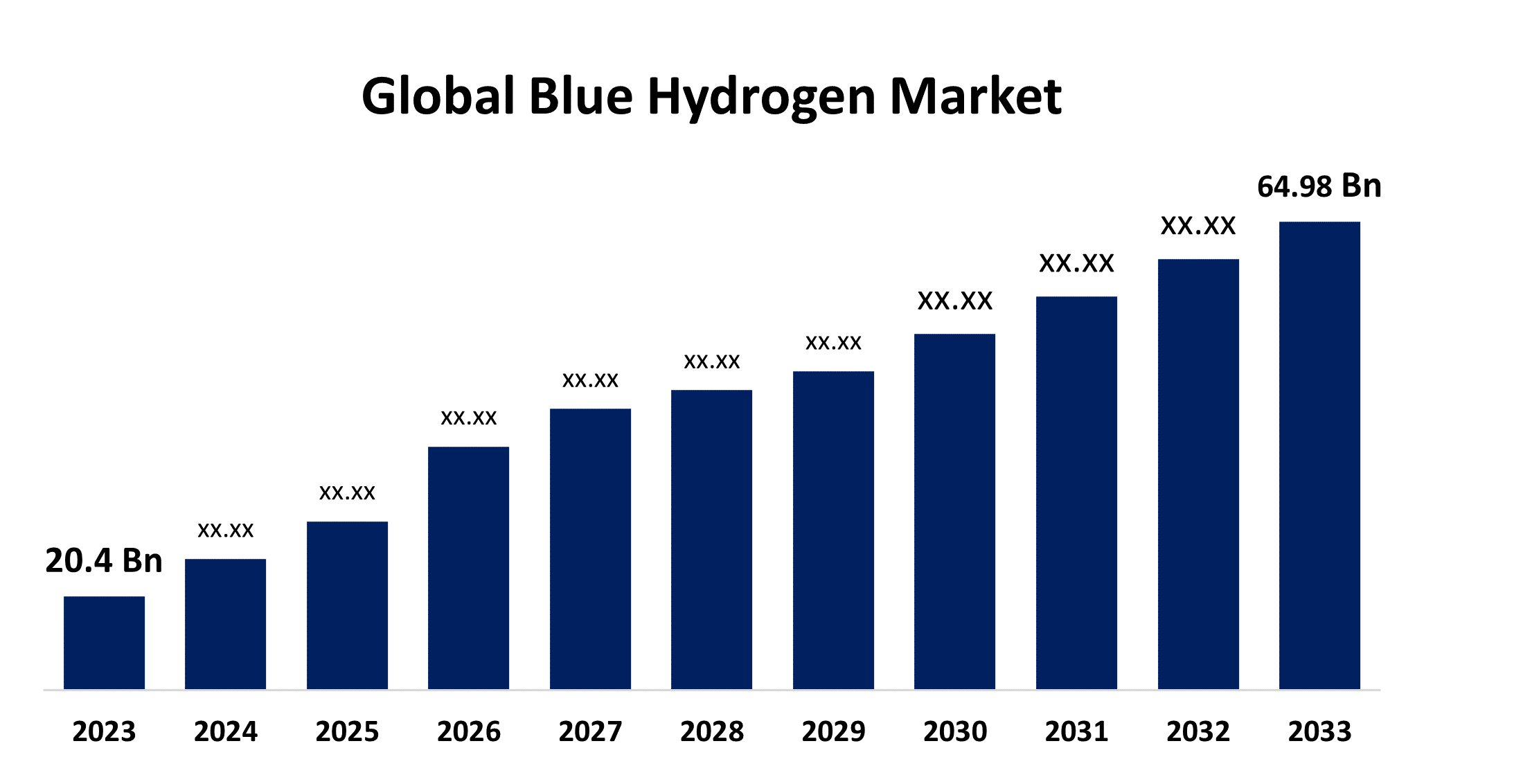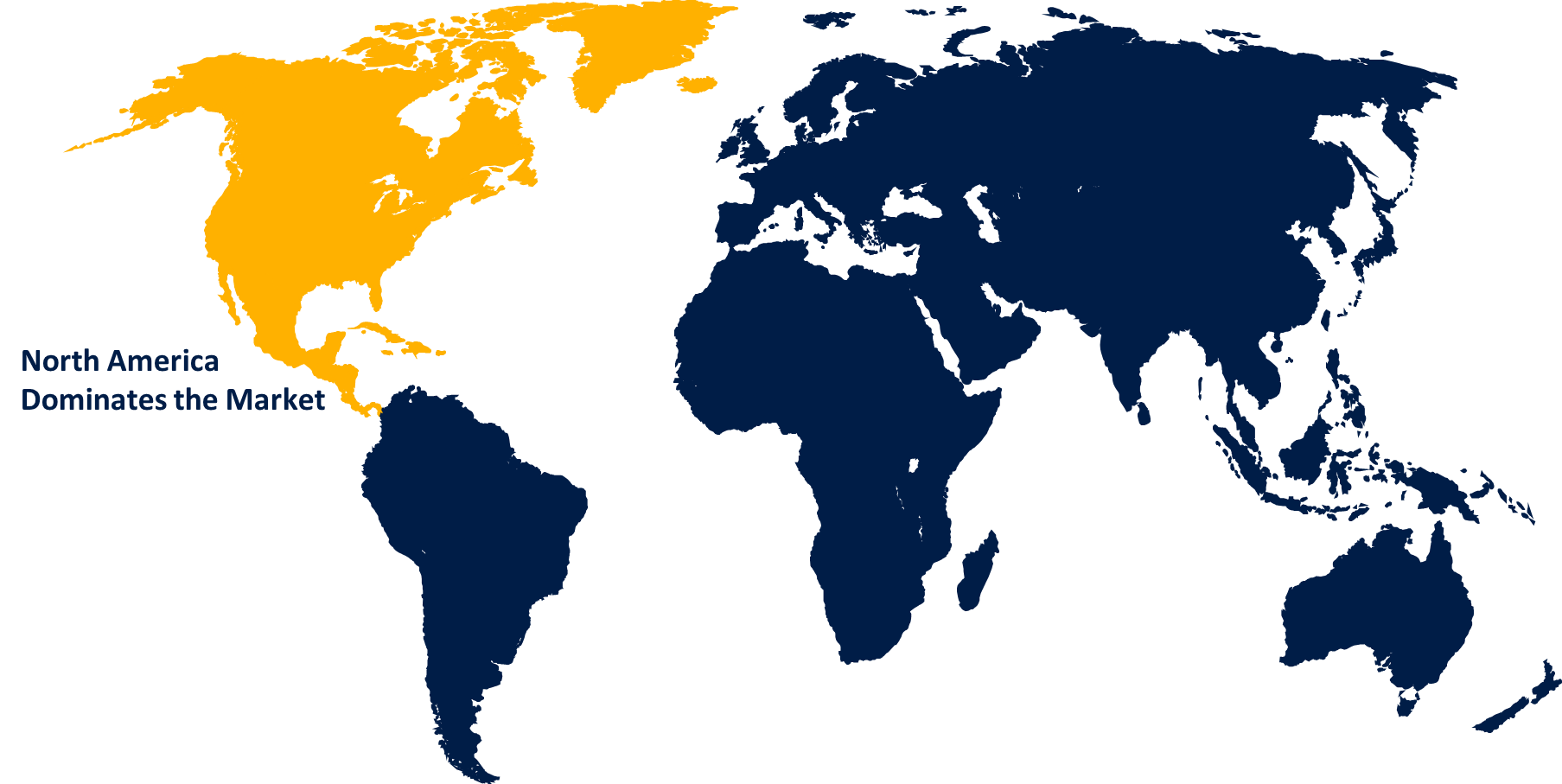Global Blue Hydrogen Market Size, Share, and COVID-19 Impact Analysis, By Technology (Steam Methane Reforming, Auto Thermal Reforming, and Gas Partial Oxidation), By End-User (Power Generation, Refinery, Chemical, and Others), and By Region (North America, Europe, Asia-Pacific, Latin America, Middle East, and Africa), Analysis and Forecast 2023 - 2033
Industry: Energy & PowerGlobal Blue Hydrogen Market Insights Forecasts to 2033
- The Global Blue Hydrogen Market Size was Valued at USD 20.4 Billion in 2023
- The Market Size is Growing at a CAGR of 12.28% from 2023 to 2033
- The Worldwide Blue Hydrogen Market Size is Expected to Reach USD 64.98 Billion by 2033
- Asia Pacific is Expected to Grow the fastest during the forecast period.

Get more details on this report -
The Global Blue Hydrogen Market Size is Anticipated to Exceed USD 64.98 Billion by 2033, Growing at a CAGR of 12.28% from 2023 to 2033.
Market Overview
Blue hydrogen is made by using a procedure known as steam reforming, which combines natural gas and heated water to create steam and it is mostly made from natural gas. As opposed to being discharged into the environment as in gray hydrogen production, carbon dioxide (CO2) created during the steam methane reforming (SMR) process is caught and stored or used in blue hydrogen production. Carbon capture, usage, and storage (CCUS) is the term for this procedure. The CO2 emitted during the generation of hydrogen is captured by the CCUS process, which then uses it in other industrial processes or stores it underground in geological formations. Compared to gray hydrogen production, which is a major source of carbon emissions, blue hydrogen production may dramatically reduce greenhouse gas emissions by absorbing, storing, or using CO2. Due to its numerous uses in industrial processes, electricity generation, and transportation, blue hydrogen has the potential to replace conventional fossil fuels with a low-carbon alternative. Additionally, without requiring major changes, blue hydrogen may be utilized in applications and infrastructure that are now fueled by gray hydrogen or natural gas. The majority of hydrogen currently manufactured is utilized in petroleum refineries and for making fertilizers.
Report Coverage
This research report categorizes the market for the global blue hydrogen market based on various segments and regions forecasts revenue growth and analyzes trends in each submarket. The report analyses the key growth drivers, opportunities, and challenges influencing the global blue hydrogen market. Recent market developments and competitive strategies such as expansion, product launch, and development, partnership, merger, and acquisition have been included to draw the competitive landscape in the market. The report strategically identifies and profiles the key market players and analyses their core competencies in each sub-segment of the global blue hydrogen market.
Global Blue Hydrogen Market Report Coverage
| Report Coverage | Details |
|---|---|
| Base Year: | 2023 |
| Market Size in 2023 : | USD 20.4 Billion |
| Forecast Period: | 2023-2033 |
| Forecast Period CAGR 2023-2033 : | 12.28% |
| 2033 Value Projection: | USD 64.98 Billion |
| Historical Data for: | 2019-2022 |
| No. of Pages: | 195 |
| Tables, Charts & Figures: | 115 |
| Segments covered: | By Technology, By End-User, By Region |
| Companies covered:: | Shell plc, Linde plc, Air Products and Chemicals, Inc., Aker Solutions, ExxonMobil Corporation, Dastur Energy, Topsoe, Equinor ASA, Uniper SE, Petrofac Limited, BP p.l.c., Eni, Technip Energies N.V., Johnson Matthey, ENGIE Group, and Others Key Vendors. |
| Pitfalls & Challenges: | COVID-19 Empact, Challenges, Future, Growth, & Analysis |
Get more details on this report -
Driving Factors
Although hydrogen has long been acknowledged as a potential low-carbon transportation fuel, it has proven difficult to use in the mix of fuels for transportation. It has an edge over fossil fuels, which are running out and becoming more expensive every day as a result. The aerospace sector has a huge demand for hydrogen to power fuel-cell electric cars and rockets. Truck manufacturers' primary focus is decreasing the price of hydrogen provided, but fuel cell prices and recharging stations also have a significant role in how competitive hydrogen fuel cell cars are in the transportation industry. There is an opportunity for hydrogen-based fuels as there aren't many low-carbon fuel alternatives for aircraft and ships. Throughout the world, hydrogen fuel cells are extensively utilized in lightweight vehicles like forklifts and bicycles, as well as in commercial aircraft, boats, ships, automobiles, buses, trains, and auxiliary power units of airplanes. The introduction of fuel cell cars should be complemented by the concurrent building of supporting infrastructure.
Restraining Factors
As methane escapes during the synthesis of blue hydrogen, natural gas contains methane, a greenhouse gas that greatly slows the increase of market profits. Moreover, using natural gas to create the substantial amount of energy needed to make blue hydrogen results in carbon dioxide emissions, which restricts the growth of revenue in the blue hydrogen industry.
Market Segmentation
The global blue hydrogen market share is classified into technology and end-user.
- The steam methane reforming segment is anticipated to dominate the market during the forecast period.
Based on the technology, the global blue hydrogen market is divided into steam methane reforming, auto thermal reforming, and gas partial oxidation. Among these, the steam methane reforming segment is anticipated to dominate the market during the forecast period. One technique for producing hydrogen from natural gas (methane) is steam methane reforming. This is one of the most affordable methods of obtaining hydrogen for industrial use. High concentrations of pure hydrogen can be produced cheaply and efficiently by steam methane reformation, this hydrogen may then be captured using in-house pressurized adsorption purification technology.
- The power generation segment is anticipated to dominate the market during the forecast period.
Based on the end-user, the global blue hydrogen market is divided into power generation, refinery, chemical, and others. Among these, the power generation segment is anticipated to dominate the market during the forecast period. Hydrogen fuel cells produce energy by combining hydrogen and oxygen atoms. During an electrochemical reaction similar to a battery, hydrogen and oxygen react to produce electricity, water, and a small amount of heat. On the other hand, hydrogen fuel cells do not produce greenhouse gases during production, unlike fossil fuels, which are expected to increase the need for blue hydrogen in the power generation sector and contribute to revenue growth in this industry.
Regional Segment Analysis of the Global Blue Hydrogen Market
- North America (U.S., Canada, Mexico)
- Europe (Germany, France, U.K., Italy, Spain, Rest of Europe)
- Asia-Pacific (China, Japan, India, Rest of APAC)
- South America (Brazil and the Rest of South America)
- The Middle East and Africa (UAE, South Africa, Rest of MEA)
North America is anticipated to dominate the market over the predicted timeframe.

Get more details on this report -
North America is anticipated to dominate the market over the predicted timeframe. Natural gas resources are plentiful in North America and can be utilized as a feedstock for the manufacture of blue hydrogen. Natural gas production in the United States leads the international market, with Canada coming in second. North America's need for low-carbon energy is rising due to environmental concerns and climate ambitions. The current natural gas production, distribution, and transportation infrastructure in North America may be leveraged for the production and transit of blue hydrogen. The time and money needed to construct blue hydrogen projects can be decreased with the use of this infrastructure. North America, with its plentiful natural gas supplies and developed infrastructure, has the potential to become a key player in the production and export of blue hydrogen.
Asia Pacific is expected to grow at the fastest pace in the global blue hydrogen market during the forecast period. This is explained by both, the region's growing energy consumption and government programs encouraging the use of sustainable energy sources. It was anticipated that South Korea and Japan, two countries in the Asia-Pacific region, would help the blue hydrogen industry expand. It is crucial to remember that the blue hydrogen industry is still in its early stages and that several variables, including infrastructure development, government regulations, and the cost-effectiveness of blue hydrogen in comparison to other energy sources, may have an impact on the market's expansion in different geographical regions.
Competitive Analysis:
The report offers the appropriate analysis of the key organizations/companies involved within the global blue hydrogen market along with a comparative evaluation primarily based on their product offering, business overviews, geographic presence, enterprise strategies, segment market share, and SWOT analysis. The report also provides an elaborative analysis focusing on the current news and developments of the companies, which includes product development, innovations, joint ventures, partnerships, mergers & acquisitions, strategic alliances, and others. This allows for the evaluation of the overall competition within the market.
List of Key Companies
- Shell plc
- Linde plc
- Air Products and Chemicals, Inc.
- Aker Solutions
- ExxonMobil Corporation
- Dastur Energy
- Topsoe
- Equinor ASA
- Uniper SE
- Petrofac Limited
- BP p.l.c.
- Eni
- Technip Energies N.V.
- Johnson Matthey
- ENGIE Group
- Others
Key Target Audience
- Market Players
- Investors
- End-users
- Government Authorities
- Consulting And Research Firm
- Venture capitalists
- Value-Added Resellers (VARs)
Recent Developments
- In March 2022, A zero-carbon liquid nitrogen facility, the new liquid hydrogen production plant in Casa Grande, Arizona, is set to be completed and put into service by Air Products Inc. by 2023.
- In January 2022, Linde plc signed a contract with Yara to build and supply a 24MW hydrogen plant.
Market Segment
This study forecasts revenue at global, regional, and country levels from 2023 to 2033. Spherical Insights has segmented the global blue hydrogen market based on the below-mentioned segments:
Global Blue Hydrogen Market, By Technology
- Steam Methane Reforming
- Auto Thermal Reforming
- Gas Partial Oxidation
Global Blue Hydrogen Market, By End-User
- Power Generation
- Refinery
- Chemical
- Others
Global Blue Hydrogen Market, Regional
- North America
- US
- Canada
- Mexico
- Europe
- Germany
- Uk
- France
- Italy
- Spain
- Russia
- Rest of Europe
- Asia Pacific
- China
- Japan
- India
- South Korea
- Australia
- Rest of Asia Pacific
- South America
- Brazil
- Argentina
- Rest of South America
- Middle East & Africa
- UAE
- Saudi Arabia
- Qatar
- South Africa
- Rest of the Middle East & Africa
Frequently Asked Questions (FAQ)
-
1.Which are the key companies that are currently operating within the market?The key companies that are currently operating within the market are Shell plc, Linde plc, Air Products and Chemicals, Inc., Aker Solutions, ExxonMobil Corporation, Dastur Energy, Topsoe, Equinor ASA, Uniper SE, Petrofac Limited, BP p.l.c., Eni, Technip Energies N.V., Johnson Matthey, ENGIE Group, and others.
-
2.What is the size of the global blue hydrogen market?The Global Blue Hydrogen Market Size is Expected to Grow from USD 20.4 Billion in 2023 to USD 64.98 Billion by 2033, at a CAGR of 12.28% during the forecast period 2023-2033.
-
3.Which region is holding the largest share of the market?North America is anticipated to hold the largest share of the global blue hydrogen market over the predicted timeframe.
Need help to buy this report?